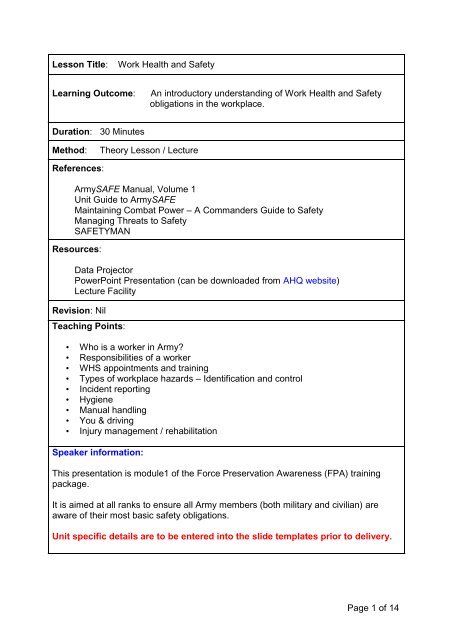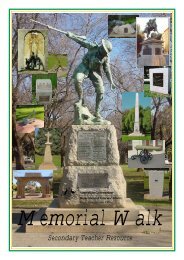Work Health & Safety Awareness Lesson Plan
Work Health & Safety Awareness Lesson Plan
Work Health & Safety Awareness Lesson Plan
You also want an ePaper? Increase the reach of your titles
YUMPU automatically turns print PDFs into web optimized ePapers that Google loves.
shifts workable by the worker, and• in any other case - 30 or more successive working daysDangerous Occurrence. An occurrence at a workplace that resulted from operationsthat arose from the undertaking conducted by an employer; and could have caused(but did not cause) the:• death or serious personal injury to any person, or• total incapacity or any employee for 30 or more consecutive shifts or days.[NEXT SLIDE]PPT 15:Speaker notes:Army workplaces and personnel may be considered prime targets for acts ofterrorism; this could include bomb / suspicious package threats or chemical, biologicalor radiological attacks. Other credible emergencies could include fire, naturaldisasters or any other emergency which may impact on Army’s capability.An emergency is any event, whether natural or man-made, which by its occurrenceendangers the health and safety of personnel, contractors and visitors to theworkplace and which necessitates an immediate response.Emergency management is necessary to ensure that appropriate responses havebeen developed to maximise the safety of personnel, contractors and visitors to theworkplace during emergencies and to minimise damage to workplace facilities and thesurrounding environment.Emergency Management <strong>Plan</strong> (EMP): The unit EMP is displayed on all notice boards.The EMP details the locations of Evacuation Routes / Fire Fighting Equipment and‘Actions On’ in the event of an emergency. Emergencies covered by the EMP are notjust limited to ‘fire’, and can include bomb threats and other scenarios in which thephysical integrity of the area has been compromised. All unit personnel are to readand be familiar with the unit EMP.You should also familiarise yourself with the Building Emergency Response <strong>Plan</strong>(BERP) for your work areas. The BERP details the evacuation details for a specificbuilding, as well as listing the local ‘actions on’.If you hear the fire alarm tone sounding, or are verbally told to evacuate, you shouldtake the following actions:• Remain as calm as possible;• Stop work and evacuate the workplace via the safest exit, or exit asdirected by ECO Wardens;• Move directly to the workplace’s primary evacuation assembly area (asdepicted on your nearest Emergency Management InformationPage 9 of 14
noticeboard); and• Follow all further directions from ECO Wardens, local security andEmergency Services personnel.[NEXT SLIDE]PPT 16:Speaker notes:One of the most effective ways we have to protect ourselves and others from illness isgood personal hygiene. This means washing your hands, especially, but also yourbody. It means being careful not to cough or sneeze on others, cleaning things thatyou touch if you are unwell, putting items such as tissues (that may have germs) intoa bin, and using protection (like gloves or condoms) when you might be at risk ofcatching, or passing on, an infection.Personal hygiene, such as bathing, is very much dependent on the culture in whichyou live. In some cultures, it is expected that you will wash your body at least everyday and use deodorants to stop body smells. Other cultures have differentexpectations.It is very important that people, who may be suffering from, or carrying, certainillnesses (or suffering from some other condition) do not handle food or food-contactsurfaces. This is particularly important if they are likely to contaminate food while theyare working.The simple facts about flu:• You cannot get flu from the vaccine – the vaccine does not contain any livevirus.• It doesn’t matter how fit or healthy you are – you are still at risk ofcontracting the flu.• ‘Natural Immunity’ is no guarantee – the flu virus changes constantly. Thereis no guarantee that your body will have built up immunity to the comingstrains of flu.• Vitamins don’t stop flu – it is not proven that vitamin C or Echinacea reduceyour risk of getting flu. Antibiotics do not work against viruses like influenza.All personnel are encouraged to get vaccinated every year – whilst vaccination is noguarantee of not contracting the flu; it is a safe and effective way to reduce the risk.[NEXT SLIDE]Page 10 of 14
PPT 17:Speaker notes:Manual handling covers more than lifting heavy weights, and affects more than yourback. Manual handling also includes:• repetitive activity seen in assembly work,• sustained muscle exertion required to restrain or support a load, and• the effort needed to maintain a fixed posture (eg that occurs in the backand neck whilst typing).All activities in the workplace involve some degree of manual handling. The activitiesmost likely to cause an injury within this unit are:(INSERT THE HIGH RISK MANUAL HANDLING TASKS)It is a supervisor’s duty to ensure that the tasks being conducted do not place theworkers at risk to manual handling injuries.Additional speaker information:NOTE FOR PRESENTERS: Manual handling activities are those that expose thebody to stress and have the potential to cause injury. These activities are stressfulmainly due to the postures and movements required by the task, the force that mustbe used and the environment in which the task is performed. When identifying highriskmanual handling tasks within your work area you should consider how likely it isthat a sprain, strain or joint injury will occur. The risk increases as the number of riskfactors involved increases. Also consider how much time a person spends doingthis task (the duration) and how often it is done (the frequency), as this willsignificantly affect the overall stress on the body.[NEXT SLIDE]Page 11 of 14
PPT 18:Speaker notes:If operating a service vehicle, or an Army funded hire car, you are to comply withDRTIs. Of particular note, all Army drivers are to have a Zero Blood Alcohol Level.Almost a third of the drivers / riders involved in fatal vehicle accidents on Australianroads in 2009 had a blood alcohol level of 0.05 g/100ml (or over).INSERT ANY RELEVANT STATE / TERRITORY ROAD RULES (IF APPLICABLE)The driver of a Defence vehicle involved in a vehicle accident is to take the followingactions:• Stop the vehicle, dismount and make the area safe.• Administer first aid to anyone injured. Anyone injured is not to be movedexcept where further injury is likely due to fire, gas, explosion, drowning etc.• If an injured person is bleeding:1. The driver is to wear surgical gloves to guard against possibleinfection.2. If gloves are not available, care is to be taken to ensure the injuredperson’s blood does not come into contact with open cuts. The driveris to wash their hands immediately after rendering assistance.3. If the injured person’s blood contacts the driver’s skin, the driver is towash with warm soapy water and contact a medical officer within 24hours.• Call or arrange for an ambulance (if required).• Move the Defence vehicle to a safe position only if it is creating a hazard toother traffic.• Report the accident to the Unit Transport Manager, and to the civilian policein the event of:1. the death or injury of any personnel, or2. when another vehicle or property is damaged or livestock is injured.• Exchange names, addresses (unit), vehicle registration numbers andinsurance company details with the other driver(s). Civilians can be advisedto contact the Defence Insurance Office (DIO) on 1800 990 900 regardingany questions on procedures for claims.• Obey any direction given by either civilian or service police. Instances ofpolice directed assistance are to be reported to the Unit TransportManager.• DO NOT admit liability for the accident or make any statement regardingpayment of compensation or repair by the Commonwealth.[NEXT SLIDE]Page 12 of 14
PPT 19:Speaker notes:In order to sustain Army’s capability, high levels of retention must be achieved throughthe appropriate management of medical related incapacity.All Army members have a responsibility under the WHS Act to report any change ofcircumstances that may impact their performance in the workplace.Where an injury or illness is attributable to service prior to 2004 - the ADF membercomes under the provisions of the <strong>Safety</strong>, Rehabilitation and Compensation Act 1988.In certain circumstances, the member may also have an entitlement under theVeterans’ Entitlement Act 1986. Both Acts, with respect to compensation, areadministered within the Department of Veterans Affairs (DVA) by the MilitaryCompensation and Rehabilitation Service (MCRS). Post 2004, the MilitaryRehabilitation and Compensation Act 2004 applies.The aim of rehabilitation is to maximise the potential of personnel who have sustainedimpairment or incapacity as a result of a service injury or disease. Rehabilitationshould restore personnel to at least the same physical, psychological, social,vocational and educational status that they enjoyed prior to any injury or disease.Members are to actively participate in a Rehabilitation Assessment and Rehabilitation<strong>Plan</strong> (when required). Failure on a member's part to participate can result indisciplinary and / or administrative sanctions, and may prejudice compensation claimoutcomes.Members who consider their injury or illness to be related to their ADF service areentitled to lodge a compensation claim – the unit Rehabilitation Advisor can assist.[NEXT SLIDE]PPT 20:Speaker Notes:Today’s training has covered a broad range of topics in a fairly short amount of time.All unit personnel must be cognisant of their inherent safety responsibilities.All unit personnel should familiarise themselves with (UNIT OHS STANDINGORDERS or UNIT SAFETY DIRECTIVE) which details the bulk of the informationcovered in this presentation.<strong>Safety</strong> is everyone’s responsibility and this concept underpins all safe systems ofwork. As a member of the Army you are to contribute to ArmySAFE by carrying outthe following as an automatic part of every activity they undertake:Page 13 of 14
• Spot the hazard / threat (identify the threat to safety and determine therisks).• Assess the risks (analyse the risk to determine the likelihood, impact andseverity)• Fix the problem (prevent and minimise the potential impact of exposure tothe hazard / risks).• Evaluate the results (consider the effectiveness of each action / decision).[NEXT SLIDE]PPT 21:Speaker notes:Are there any questions on <strong>Work</strong> <strong>Health</strong> & <strong>Safety</strong>?[QUESTIONS][NEXT SLIDE]PPT 22:Speaker notes:Additional information on WHS Issues can be found by contacting the USA (INSERTNAME) or by visiting the ArmySAFE website.END OF PRESENTATION[NEXT SLIDE]PPT 23:Speaker notes:Army ‘cover’ slide for display on completion, and whilst next presentation is arranged.Page 14 of 14











